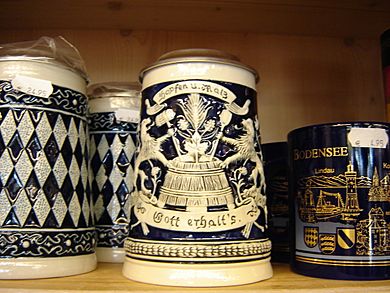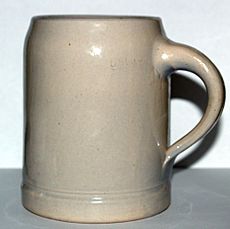Beer stein facts for kids

A beer stein, or simply stein, is a special kind of drinking mug. It's often made from materials like stoneware or porcelain. Sometimes, steins are sold as cool souvenirs or items to collect. An old magazine article from 1894 even said that we can thank the German people for these amazing mugs!
These unique mugs can be made from many different materials. You might find them in stoneware, pewter, porcelain, or even silver, wood, or crystal glass. Many steins have a hinged pewter lid that you can open with your thumb. Steins usually hold about half a litre or a full litre of liquid. They are often decorated with designs that remind people of Germany.
Contents
What Does "Stein" Mean?
The English word "stein" started being used around 1855. It comes from the German word Stein. In German, Stein mostly means "stone." But long ago, in some parts of Germany, it also meant "beer mug" or a specific amount of beer (like one litre).
You can compare this word to an old English word, "stæne," which meant "pitcher" or "jug."
Today, the word Stein by itself isn't used in standard German for a drinking container. Instead, Germans use words like Krug, Humpen, or Seidel, especially in places like Bavaria and Austria. At the famous Oktoberfest festival, a large one-litre mug is called a Maßkrug.
A Look Back in Time
Some people used to think that the hinged lid on steins was added during the time of the Black Death (a terrible sickness). They thought it was to stop sick flies from getting into the drinks.
However, this idea is probably not true. People back then didn't know that fleas spread diseases. They believed sickness spread through bad air.
Using stoneware to make steins was a great idea because artists could use molds to make many fancy, carved mugs. When glass was used, not only could many mugs be made, but artists could add special touches. They could use acid to etch designs, stain the glass, or even add colorful layers.
Porcelain was good because makers could create "character steins." These were mugs shaped like specific items or characters. Collecting old and new steins became a very popular hobby for people and even museums. While many steins are now made in America, the biggest producer is Ceramarte, located in Brazil.
The most traditional place for making beer steins is the Kannenbäckerland region in Germany. This area has been making steins for hundreds of years. It is famous among collectors as the original home of German beer stein production.
On September 21, 2014, a person named Oliver Strumpfel set a record. He carried 25 full beer steins over 40 metres (130 ft) without spilling! That's a lot of steins!
What Are Steins Made Of?
In many parts of Europe, especially England, beer steins were mostly made from pewter. But many steins were also made from glass, porcelain, and silver. You could also find steins made from wood, earthenware, and crystal.
Today, regular German drinking mugs are often made of glass. This is because glass is easy to keep clean. Glass mugs became popular at the Oktoberfest festival in 1892. Most modern drinking mugs, unless they are special decorative ones, do not have a lid.
Large drinking mugs (0.5 and 1 litre) are very common in beer gardens and especially at Oktoberfest. They are popular because they are strong and don't break easily. In other places, smaller 0.33 and 0.5 litre glasses are also popular.
Sometimes, people have tried to use plastic mugs instead of glass or earthenware ones, usually for safety reasons. But in Germany, these attempts have often led to protests and were not successful for very long.
Why Do Steins Have Lids?
The lids on these drinking mugs are for keeping things clean. They especially help to keep insects out of the drink. These lids are usually made of pewter. They often have a small lever that you can reach with your thumb. This way, you can hold the mug and open or close the lid with just one hand.
Today, people often use drink mats to cover their glass or mug when needed.
Other Names for Drinking Mugs
In German-speaking areas, drinking mugs might be called different names:
- Bierkrug (meaning "beer mug")
- Maßkrug or Maß (for a one-litre mug)
- Humpen
- Adlerhumpen, a tall drinking glass, sometimes with lids decorated with the double eagle symbol of the Holy Roman Empire
- Seidel or Seidla (in Franconia, meaning a half-litre mug). The word Seide is also used by the Pennsylvania Dutch people.
- Schoppen (in the Palatinate region, meaning a half-litre mug)
- Keferloher, a traditional stoneware mug without many decorations. It's named after the village of Keferloh near Munich, where they were first made.
Some popular collectible designs include brewery symbols, Bavarian pictures like Neuschwanstein Castle, or the famous Rathaus-Glockenspiel clock in Munich. The colorful official souvenir mug from the annual Oktoberfest, which features the winning poster design of the year, is also very popular.
Using these large drinking mugs is not as common in most parts of Northern and Central Germany. In those areas, they are often seen as a special item from Bavaria.
Images for kids
-
A beer mug celebrating Milwaukee City Hall
See also
 In Spanish: Humpen para niños
In Spanish: Humpen para niños








